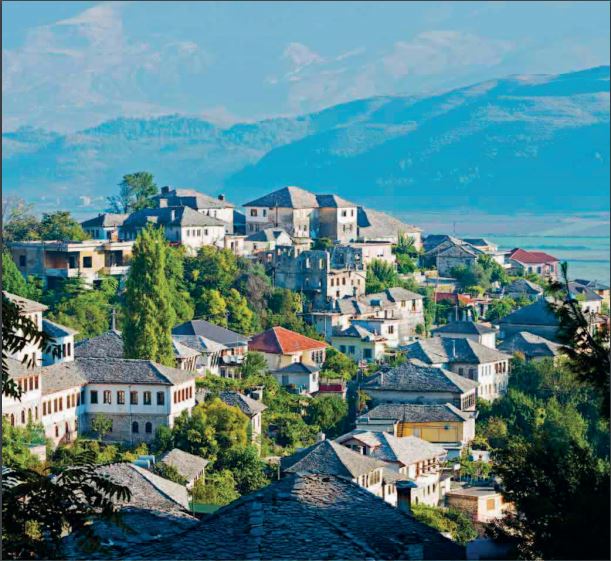the rough guide to Albania
Introduction
Tell your friends or family that you’re off to Albania, and you’ll likely receive
a stock response: “Isn’t it dangerous?”, “Isn’t there a war going on there?”,
and “Is that even in Europe?” are some of the most common. Speak
instead to those who have been, and the associations with the country’s
name become infinitely more positive – you’ll hear of rippling mountains,
Ottoman architecture, pristine beaches and endlessly hospitable locals.
Following decades of isolationist rule, this rugged land still doesn’t seem to
fit into the grand continental jigsaw, with distinctly exotic notes emanating
from its language, customs and cuisine. Pay a visit to this beguiling corner
of Europe now, before it garners the popularity it deserves.
Most travellers make a beeline for the
capital, Tirana, a buzzing city with a
mishmash of garishly painted buildings,
traditional restaurants and trendy bars.
However, those seeking to take
Albania’s true pulse should head to the
mountainous hinterlands, particularly
the peaceable hillside towns of Berat and
Gjirokastra – both essentially open-air
museums of life in Ottoman times.
The muscular, snowcapped peaks of
the interior drop down to a series of
immaculate beaches, most notably along
the Ionian coastline in the south of the
country, one of the Mediterranean’s most
remote and least developed stretches.
ARRIVAL AND DEPARTURE
It’s getting ever easier to fly into Albania,
with the number of international
connections increasing every year. Local
low-cost carrier Belle Air (Wbelleair.it)
flies to Tirana’s Mother Teresa airport
(Wtirana-airport.com) from several Italian
cities, as well as London, Athens and
Vienna. Direct British Airways flights
from London can be quite reasonable,
while in warmer months you can fly
cheaply to Corfu then get a ferry to
Saranda (see p.59). Visas are not required
for citizens of most nations; South Africa
is a notable exception.
Greece offers by far the simplest
international bus connections – there
are daily services to Tirana from both
Athens and Thessaloniki (from €25),
and it’s also possible to get direct buses
to a number of other Albanian cities.
From Macedonia there are direct
services from Tetovo (west of Skopje) to Tirana, via Struga and Elbasan. It is still
not straightforward to get here from
Montenegro – there are no services at
all from the capital Podgorica, though
there are a couple of daily buses, and
some unofficial minivans, linking
Shkodra and Ulcinj.
The most interesting form of arrival
is by ferry. Several operators make
overnight sailings to Durrës from Bari
in Italy, including Ventouris Ferries
(Wventouris.gr; from €56); it’s also
possible to get to Saranda by ferry from
Corfu (Wionian-cruises.com; from €19),
with at least two ferries per day making
the thirty-minute hop.

GETTING AROUND
Getting from A to B is a little tricky
in Albania – you’re advised to be
flexible, exercise patience, and to
treat travel information as a guideline
rather than gospel.
Most travel is conducted by bus; the
vehicles are usually Italian dinosaurs but
fares are cheap, and the roads are
continually being improved. However,
the authorities have steadfastly refused
to build any bus stations – fine in smaller
towns, but a nightmare in a city as large
as Tirana where matters are utterly
confusing. Buses are supplemented by
minibuses known as furgons, which are
more numerous but run to no fixed
schedule; with no obligation to depart
until full, drivers tend to roam around
town until they have the required
number of passengers, and they make a
habit of overcharging foreigners.
Albania also boasts a limited, ageing
train network. The main line runs
from Tirana to Vlora, via Durrës,
while there’s also a route heading north
to Shkodra. InterRail passes are not
valid in Albania, and would be pretty
pointless in any case.

ACCOMMODATION
Accommodation is surprisingly plentiful
for a country with such low tourist
numbers, and while state-owned
monstrosities were once the norm, arecent building boom has unleashed a
whole generation of clean, good-value
hotels. You should be able to find a
double room for under €25 (prices are
almost always quoted in euros), and
breakfast is usually included. There
don’t tend to be any set rates for single
rooms, but you can expect a small
discount from the regular rate. During
summer, private rooms come into play
at beach resorts, and there are now
hostels in Tirana, Saranda and Berat,
charging €10–14 for dorm beds; all
have free wi-fi. There are almost no
dedicated campsites, though the
secluded beaches of the Ionian coast are
great for those who can manage without
facilities. Wild camping is fine in
theory, but leaves you at the mercy of
the (occasionally corrupt) local police.



